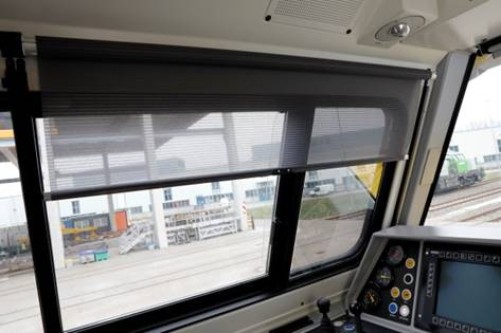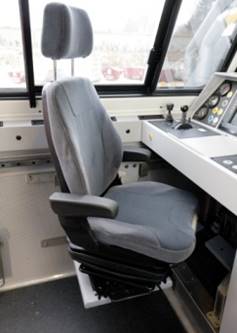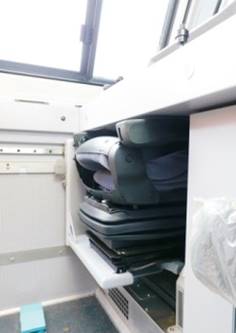A driver’s cab that provides everything an ultramodern working environment requires is worth its weight in gold – especially on longer runs.
The comfortable furnishings on the DE 18 – the sophisticated lighting concept, the ergonomic, clearly arranged configuration of the operator’s controls and display instrumentation, the air-conditioning – are all set up to meet the needs of the personnel. Speeds of up to 120 kilometres per hour go without saying; as does multiple unit operation.
Well laid out driver’s console
All the operator’s controls and display instruments are arranged clearly and ergonomically. The locomotive driver has an excellent 360 degree view through the front and side sliding windows, and he can see along the locomotive all the way to the buffers. Two windows in the cab door let in even more daylight, and easily adjustable sunblinds on the front and side windows protect against unwanted glare.
 Sun protection for the front and side windows
Sun protection for the front and side windows  Rotatable driver seat
Rotatable driver seat Retractable driver seat
Retractable driver seat
There’s enough space in the cab for driver and assistant to work comfortably. The two revolving driver’s seats can be folded away for stand-up operation and have suspension systems for extra driving comfort with height-adjustable footrests that ensure a safe sitting position. The locomotive is certified to carry a further two people.
Air conditioning and air circulation
Two electrically powered fan convectors mounted under the footrests at the driver’s consoles heat the air in the driver’s cab. Their dual function is to provide the cab with fresh air from outside and heat it in cold weather conditions. The air-conditioning unit mounted on the roof is operated from the console, and the air circulation feature heats the cab up faster when it’s cold. The integrated fine particulate filter on the outside air supply for working in dusty environments, e.g. in tunnels or during infrastructure works (e.g. while ballasting), operates according to the highest quality standards (M6 according to EN 779). The driver can also switch off the supply of air from outside in order to completely prevent any smoke or fine dust from entering the cab.
Very good interior lighting
The locomotive’s cab is equipped with different lighting systems. The general lighting in the form of two ceiling lights can be switched on permanently or for a predetermined duration from inside the cab. The general lighting together with the lighting on the steps can be switched on for a predetermined duration from outside the cab using push buttons located at all four entry points. If the power supply is interrupted, the general lighting can continue to be used for up to three hours as part of the emergency lighting.
The instrument panel illumination for the display instruments and operator controls on the driver’s consoles is of course dimmable. This also applies to the ceiling spotlight that serves as a reading light for reading schedule books while at the driver’s consoles. Floor lighting runs along the gangways, steps and access doors to the cab so that personnel can negotiate them safely.



